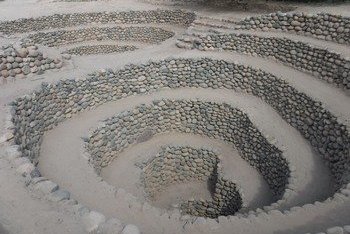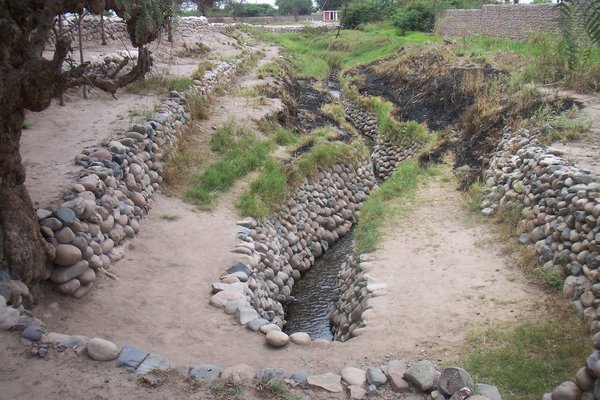Peru
Nasca Aqueducts
Nasca Aqueducts is a network of underground aqueducts built by the Nazca people to carry and use the intermittent water sources of the Andes in the dry desert of the region. This was made possible by the development of several technical innovations, including reservoirs, a filtration system, and above all helical openings to equalise the pressure between the inside and outside of the pipe and thus ensure a constant flow in the pipe. This hydraulic system was built in one of the driest deserts on the planet and represents an exceptional adaptation to these difficult conditions, allowing at the same time the colonisation of these territories and the practice of agriculture.
Site Info
Official Information
- Full Name
- Nasca Aqueducts (ID: 6407)
- Country
- Peru
- Status
-
On tentative list 2019
Site history
History of Nasca Aqueducts
- 2019: Added to Tentative List
- Added to tentative list
- Type
- Cultural
- Criteria
Links
- UNESCO
- whc.unesco.org
All Links
UNESCO.org
- whc.unesco.org — whc.unesco.org
Community Information
- Community Category
- Secular structure: Civic and Public Works
Travel Information
Recent Connections
News
No news.
Recent Visitors
Visitors of Nasca Aqueducts
- AC
- alex
- basementonline
- Bram de Bruin
- Carlos Sotelo
- Christravelblog
- Clyde
- Delphine Delaunay
- Dennis Nicklaus
- emvcaest
- Francky D'Hoop
- Frédéric M
- George Gdanski
- Ingrid
- Javier Coro
- Joel on the Road
- Kevin McFarland
- Mathijs
- nan
- Patrik
- Philipp Peterer
- Piotr Wasil
- Riccardo Quaranta
- RYU
- Sergio Arjona
- Shandos Cleaver
- Stanislaw Warwas
- Svein Elias
- Tevity
- Timonator
- tony0001
Community Reviews
Show full reviews
The Nasca Aqueducts are a very impressive work of hydrological engineering from the pre-Columbian Nazca culture. The Cantalloc Aqueducts are the best preserved of these, just outside the city of Nazca. The Nazca culture flourished between about 200 and 700 A.D., and these aqueducts are generally dated to around 300 A.D. Several of them still have water flowing through them and are useful today. A large part of the extensive network of water channels (many kilometers) is/was underground, which makes the work even more impressive to me, that the ancient Nazca were able to build and maintain these. At Cantalloc, the most visually striking element are the broad spiral access points. These stone-lined spiral wells provided ventilation needed to keep the water flowing as well as access points for water collection. I was told there were 14 of the spirals at the Cantalloc site remaining, although access to some of them was restricted during my visit. Not a big deal as they are mostly all the same.
The OUV of this site was apparent to me, demonstrating the ingenuity of this ancient culture to master the handling of precious water in the desert.
What you'll see at the site
We started off at the open irrigation channel that's at the end of the aqueducts. It's a nice stone lined ditch with some shade trees, nothing special on its own. Then, as you walk upstream, you come across the spiral access points. There are several in a row, …
Keep reading 0 comments
Part of the appeal of the Nasca Lines, is the fact that they seem so out of place. Clearly, the people who created them had knowledge and skill. But why would they settle in the middle of the desert in the first place? From the bus window all I saw was sand. The Nasca Aqueducts help to explain a little how they survived here: They set up an elaborate water management system enabling to conduct agriculture.
As usual with tentative sites it's pretty hard to say what the final scope of the inscription will be. I would assume the Cantalloc Aqueducts in town are part of the site, but who knows?
OUV
As stated year's back in my original review, I feel this should be part of the Nasca WHS itself. As an extension to illuminate the Nasca culture more I would be fully in favour of including some settlements as well as water management sites. As a separate site, though, this would feel redundant.
Getting There
It's a simple walk from the town center to the Cantalloc Aqueduct. However, Lonely Planet claimed the neighbourhood was dangerous. Not sure about that. From the aqueduct you can also reach the lines at Telar and the old settlement at Los Paredones.
Nasca itself is connected by bus to both Lima and Arequipa (more details in my Nasca review). Next major town is Ica.
While You Are There
Obviously, if have made it to …
Keep reading 0 comments

